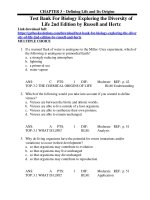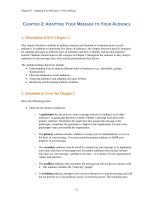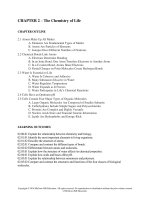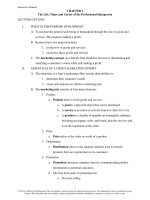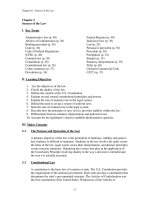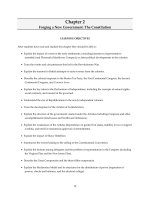Test bank and solution ch02 the chemistry of life (1)
Bạn đang xem bản rút gọn của tài liệu. Xem và tải ngay bản đầy đủ của tài liệu tại đây (574.44 KB, 18 trang )
CHAPTER 2 – The Chemistry of Life
CHAPTER OUTLINE
2.1 Atoms Make Up All Matter
A. Elements Are Fundamental Types of Matter
B. Atoms Are Particles of Elements
C. The Number of Neutrons May Vary
2.2 Chemical Bonds Link Atoms
A. Electrons Determine Bonding
B. In a Covalent Bond, Atoms Share Electrons
C. In an Ionic Bond, One Atom Transfers Electrons to Another Atom
D. Partial Charges on Polar Molecules Create Hydrogen Bonds
E. Bonds Break and Form in Chemical Reactions
2.3 Water Is Essential to Life
A. Water Is Cohesive
B. Many Substances Dissolve in Water
C. Water Regulates Temperature
D. Water Expands as It Freezes
E. Water Participates in Life’s Chemical Reactions
2.4 Organisms Balance Acids and Bases
2.5 Organic Molecules Generate Life’s Form and Function
A. Carbohydrates Include Simple Sugars and Polysaccharides
B. Lipids Are Hydrophobic and Energy-Rich
C. Proteins Are Complex and Highly Versatile
D. Nucleic Acids Store and Transmit Genetic Information
2.6 Investigating Life: E. T. and the Origin of Life
LEARNING OUTCOMES
02.00.01 Explain the chemical nature of biological molecules.
02.01.01 Identify the most important elements in living organisms.
02.01.02 Describe the structure of atoms.
02.02.01 Compare and contrast the different types of bonds.
02.02.02 Differentiate between atoms, molecules, and compounds.
02.03.01 Explain how the structure of water affects its chemical properties.
02.04.01 Explain how acids and bases affect pH.
02.05.01 Explain the relationship between monomers and polymers.
02.05.02 Compare and contrast the structures and functions of the four classes of biological
molecules.
02.06.01 Explain how researchers used isotopes to test hypotheses about the extraterrestrial origin of
organic molecules.
WHERE DOES IT ALL FIT IN?
Chapter 2 provides an overview of the basic principles of chemistry making up the first hierarchal
level of living systems discussed in Chapter 1. The chemistry concepts and terminology can be
intimidating to many students because of the diversity of concepts needed to build an understanding
of biological molecules. Reinforce to students that the elemental chemistry being covered in this
chapter is essential for understanding cell structure and organismic function, and principles of
homeostasis being taught during the semester. The scope of information about organic matter
covered in Chapter 2 sets down the foundation of understanding cell metabolism, cell replication, cell
structure, genetics, and membrane transport. Regularly refer to Chapter 2 when discussing the topics
that rely on information about elements, organic molecules, and the properties of water.
SYNOPSIS
This chapter presents students with the basic chemistry background essential for understanding the
underlying principles of biology. Living organisms can be viewed as chemical machinery composed
of molecules that build their structure and that take part in chemical reactions that run a variety of
metabolic reactions. The chapter demonstrates the roles of elements and molecules to the function
and structure of organisms and their interaction with the environment. Basic concepts about atoms
and elements are discussed in a way that is pertinent to biological systems. Emphasis is placed on the
biological roles of ions and bonding. The important features of isotopes pertinent to living systems
are also discussed.
The properties of water are also discussed in this chapter. The features of water that permit cell
function and the overall survival of organisms on the Earth are highlighted. Examples of water’s
characteristics are illustrated using examples of how organisms adapted to the Earth’s watery
environment. It is stressed that water is the main unifying molecule that maintains the chemical and
physical environmental conditions needed for cells and organisms to function. Coverage is also given
to pH and its role in organisms and the environment. Buffers are introduced, as well as information
about how organisms regulate their internal environments.
Organic molecules are later introduced in the chapter once the foundations of elements and bonds are
established. The chapter introduces the fundamental properties of biological molecules and their
existence as monomers and polymers. Each group of molecules is then introduced. The basic
chemistry and biological roles of carbohydrates, lipids, proteins, and nucleic acids are discussed.
Examples of common monomers and polymers are discussed. Enough background about each group
of molecules is provided to promote class discussions about environmental health, medical
treatments, and nutrition.
CONCEPT MAP
Concept mapping is a structured graphical presentation of the concepts covered in a particular
topic. The following concept map represents the links between the information covered in this
chapter. It is important to tell students to develop their own concept maps after covering the
particular information covered in class.
COMMON STUDENT MISCONCEPTIONS
There is ample evidence in the educational literature that student misconceptions of information
will inhibit the learning of concepts related to the misinformation. The following concepts
covered in Chapter 2 are commonly the subject of student misconceptions. This information on
“bioliteracy” was collected from faculty and the science education literature.
Mass and weight are the same and they are equal at all times.
The density of an object depends only on its volume.
Atoms can be seen with a standard microscope.
The terms atoms and elements are synonymous in meaning.
The atomic nucleus is large and in close proximity to the orbitals.
The electron shell is there to protect the nucleus.
Elements of solids are hard, whereas elements of gases are soft.
Atomic mass values are affected by electron number.
All bonds store and release energy.
Ionic compounds form neutral molecules such as Na+Cl- in water.
Electrons in covalent bonds belong to the particular atom they came from.
Electron pairs are equally shared in all covalent bonds.
The strength of acids and bases is the same thing as its concentration.
Substances containing H are acidic; substances containing OH are basic.
The pH scale represents a linear change in measurement.
Buffers make a solution neutral.
All acids and bases are harmful and poisonous.
Salts don’t have a pH value.
pH is a measure of acidity.
The chemistry in biological systems does not follow all the same rules of chemistry.
Students are unsure about the hierarchical order of atoms, molecules, and cells.
Carbohydrates serve only as a source of fuel for the body.
All polysaccharides are starches.
All carbohydrate polymers are for food storage.
Proteins are not energy sources for the body.
There are only 20 types of amino acids in nature.
Amino acids and proteins are not related molecules.
Fats produce more energy than carbohydrates.
Fats only serve as a stored source of energy.
Students often confuse amino acids and nucleic acids.
All proteins have tertiary structure.
Proteins are a 100% representation of the DNA information.
Nucleic acids solely serve the purpose of genetic material.
Saturated fats are bad, while unsaturated fats are good.
Cholesterol is bad for the body.
Fats travel as clumps of insoluble material in the blood.
Organic molecules are only produced by organisms.
The following articles provide strategies for increasing bioliteracy in the college classroom:
Baldwin JD, Ebert-May D, Burns, D. 1999. The development of a college biology self-efficacy
instrument for non-majors. Science Education 83(4): 397-408.
Ebert-May D. 2001. Research-based change: how one college professor approached the
challenge of changing teaching. In: Implementing the Science Standards in Higher Education,
eds. W. J. McIntosh and E. Siebert, pp. 36-39. Arlington, VA: National Science Teachers
Association.
Khodor J, Halme DG, Walker GC. 2004. A Hierarchical Biology Concept Framework: A Tool
for Course Design. Cell Biology Education, 3(2): 111-121.
Klymkowsky MW, Garvin-Doxas K, Zeilik M. 2003. Bioliteracy and teaching efficacy: what
biologists can learn from physicists. Cell Biol Educ, 2(3):155-61.
INSTRUCTIONAL STRATEGY PRESENTATION ASSISTANCE
Molecular models are quite helpful when reinforcing the concept of molecular structure. Many
aspects of chemistry such as the differences between isomers just don’t work on a twodimensional surface. Three-dimensional isomer models can be built and shown to the class.
Large plastic or polystyrene molecular model kits usually used to teach organic chemistry are
appropriate for large lecture sections. The importance of molecular shape in living organisms can
be demonstrated using hands and different size gloves. The hands can represent a substrate and
the gloves represent an enzyme that must bind with the substrate.
Researchers have been known to use common objects to represent the structure of molecules
they were studying. Provide students with tangible examples of 3-D molecular structure by
constructing molecules from polystyrene balls and straws. Pop-it beads are valuable for
describing polymerization of nearly all of the molecules of life, especially amino acids forming
polypeptide chains. A coiled telephone cord effectively resembles an alpha helix while a zigzag
strip of crimped paper can demonstrate pleated sheets.
The characteristics of water become intuitive to students when related to everyday observations
such as the tempering effects on weather, sweating, surface tension, and so forth. Use as many
common examples as possible. Students can measure the relative pH of various household
solutions using tea – the normal unadulterated drinking variety. Tea becomes more yellow in
color when lemon juice is added because the juice is acidic, not because the tea is diluted by a
yellow liquid. Red cabbage is also an acid-base indicator; red when acid, blue when basic.
Construct protein amino acid sequence demonstrations by using a chain of pop beads composed
of 20 differently labeled beads to represent the 20 different amino acids commonly making up
proteins (the beads can be labeled with an indelible marker). The beads can be put together to
show the variation in primary structure. Pipe cleaners, or wire, can be used to help demonstrate
secondary, tertiary, and quaternary structure.
It is encouraged to use some lecture or recitation time to discuss the “What’s the Point?,” “Why
We Care,” “Burning Questions” boxes, and the end-of-chapter reading titled “Investigating Life:
E. T. and the Origin of Life.” The information in these resources encourages students to use the
chapter information in critical thinking situations.
When assigning the chapter as a reading, encourage the students to stop and complete the
“Mastering Concepts” features as a way of assessing their knowledge of what they read. In
addition, the “Pull It Together” provides students with a visual summary of the important
concepts in the chapter.
HIGHER LEVEL ASSESSMENT
Higher level assessment measures a student’s ability to use terms and concepts learned from the
lecture and the textbook. A complete understanding of biology content provides students with the
tools to synthesize new hypotheses and knowledge using the facts they have learned. The
following table provides examples of assessing a student’s ability to apply, analyze, synthesize,
and evaluate information from Chapter 2.
Application
Analysis
Synthesis
Evaluation
Have students apply the concept of water cohesion to the properties of
glue.
Ask students to explain why the digestive system of animals must be
adapted to break down covalent bonds yet there is no particular
mechanism for breaking down ionic bonds.
Ask students to explain why foods high in saturated fats stay fresher than
foods high in unsaturated fats.
Ask students to select and analyze three characteristics of water that
would help an organism survive in the desert.
Ask students to explain why keeping track of dietary amino acid intake is
more important than just knowing what proteins are being taken in the
diet.
Ask students to explain what nutrient molecules would be deficient in
food if crop plants were deprived of fertilizers containing nitrogen and
phosphorus.
Ask students to come up with potential agricultural uses of an instrument
that measures the types of elements found within an intact living
organism.
Ask students to design a hypothetical low calorie food using isomers of
carbohydrates and alternative forms of lipids.
Ask students to describe how an organism would have to adapt to
extremely hot environmental conditions in which the tertiary structure of
normal proteins is disrupted.
Ask students to discuss the probability of life on a planet that is not
abundant in the elements that form covalent bonds.
Ask students to evaluate the difference between nutrients obtained from
nature versus those produced synthetically in a laboratory.
Ask students to explain why the molecules in organisms found on
another planet may not be of nutritional value to humans.
BIOETHICAL CONSIDERATION
Biological knowledge contributes to the betterment of human society in many ways. However,
there are also various ethical concerns that are raised by the applications of this knowledge. An
understanding of molecular structure has permitted scientists to create synthetic versions of
naturally occurring biological molecules. These molecules are commonly used as medications
and as nutritional supplements such as vitamins. An ethical consideration called “Vitamin E
scare study used synthetic, not natural vitamin E” presents students with one concern about
synthetic versus natural vitamins. Ask students to discuss the rationale for the writer’s view and
whether the view is consistent with the science of molecular structure. The issue can be found at:
/>
FUN FACTS
Trivial facts about biology are a fun way to spice up a lecture. They can be read in class or
placed at appropriate points into a lecture using the board or a projected presentation. The trivia
can be used as a jumping point for students to further investigate the fact.
The only letter not appearing on the periodic table of elements is the letter J.
Matter making up the Earth weighs approximately 7,000,000,000,000,000 tons.
Types of matter called atoms were believed to exist by the Greeks about 2,400 years ago.
At room temperature, the average air molecule travels at the speed of a rifle bullet.
Air becomes liquid at about -190o C.
Cellophane food wrap is not made of plastic, rather it is made from cellulose that has
been shredded and aged.
In a 100-year period, a water molecule spends 98 years in the ocean, 20 months as ice,
about two weeks in fresh water bodies, and less than a week in the atmosphere.
An average adult human body contains around 250 g or ½ lb of salt.
The amount of carbon in the human body is enough to fill about 9,000 lead pencils.
It is estimated that a plastic container can resist decomposition when buried in a landfill
for as long as 50,000 years.
A bee sting is acidic and a wasp sting is alkali.
IN-CLASS CONCEPTUAL DEMONSTRATION
Exposing the Carbon Skeleton of Organisms
Organic chemistry is often the least enjoyable subject covered in general biology courses. This
demonstration reinforces the fact that all organic molecules have a carbon skeleton. It shows the
prevalence of carbon in organic molecules versus inorganic molecules. Plus, it demonstrates the
amount of bond energy stored in organic molecules. It uses sulfuric acid to break down the
covalent bonds of organic molecules releasing the oxygen and hydrogen. What remains in the
container is a carbon mass puffed with gases (carbon dioxide and sulfur oxides) released by the
molecular degradation.
Special Precautions
Caution must be used with this demonstration. It produces a rapid burst of heat
and noxious fumes. It should be done using personal protection equipment
(gloves, goggles, and a laboratory apron) and in a well-vented area near a source
of running water. Be careful to conduct the demonstration in a manner that
students cannot be harmed if the glass container cracks. The waste remaining
from the demonstration should be disposed in an acid waste container.
This procedure can be shown to a large class using a videocam attached to an LCD projector.
Materials
Large glass thermometer
Three 400 ml Pyrex®, or equivalent glass, beakers
Three large glass test tubes
300 ml of room temperature water
Bottle of sucrose solution with dropper (20 g sucrose/100 ml water)
Bottle of amino acid solution with dropper (20 g amino acids/100 ml water)
Bottle of table salt solution with dropper (20 g table salt/100 ml water)
Bottle of concentrated sulfuric acid solution with dropper
Roll of aluminum foil
Personal protection equipment
Procedure and Inquiry
1. Explain to the class that you will be demonstrating the carbon composition of organic
molecules compared to inorganic molecules.
2. Lay down a sheet of aluminum foil on the table where the demonstration will take
place.
3. Place one beaker in the middle of the foil.
4. Add 100 ml of water to the beaker.
5. Place one test tube into the beaker.
6. Add 5 ml of sucrose solution to the test tube while explaining your action to the class.
7. Place the thermometer in the beaker so that the bulb is touching the base of the test
tube.
8. Announce to the class the starting temperature of the solution.
9. Slowly add approximately 2 ml of the concentrated sulfur acid (do not mix or stir).
10. Direct the class to observe what happens (the solution will darken followed by the
rapid eruption of a black column of “puffy material”).
11. Announce to the class the final temperature of the solution.
12. Repeat steps 4 through 11 for the amino acid and salt solutions.
13. Ask the class to explain the elemental composition of the “puffy material” (they
should be directed to answer carbon with hydrogen gas and carbon dioxide).
14. Ask them why the table salt solution did not show carbon “puffy stuff”.
15. Ask the class to explain the temperature elevation (they should explain it was due to
the energy released by the breakage of covalent bonds).
16. Ask the students what they should expect to find if a similar demonstration was
performed on the following materials:
A piece of chalk
Lump of bacon fat
A piece of paper
USEFUL INTERNET RESOURCES
1. The value of the periodic table is often understated in introductory biology lectures.
Instructors can show the importance of the periodic table relating an element’s placement
on the table to its bonding property with other elements. An excellent website hosted by
Iowa State University facilitates the relationship between certain elements found in
organic molecules and their capacity to form covalent bonds. The website is located at
/>bonding1.swf.
2. Animated three-dimensional models of biological chemicals add an exciting component
to a lecture from Chapter 2. These images can be manipulated and altered to demonstrate
different aspects of a wide array of molecules. The World of Molecules website
maintains a sample database of
interactive 3-D molecules that can be displayed in class. Another good website is from
the University of Massachusetts at This
website demonstrates how researchers use interactive 3-D computer models of molecules
in biological research.
3. A lecture on pH can be enlivened by demonstrating the pH of various household and
laboratory compounds. Birmingham Grid for Learning hosts an interactive website for
demonstrating the pH properties of various compounds using virtual litmus paper or
universal indicator. It even guides students through buffer reaction predictions. This
entertaining interactive website is found at
/>4. Visual demonstrations of laboratory activities are important for ensuring students are
collecting the correct data for analysis. This website instructs students on the chemical
analysis methods used to identify carbohydrates, lipids, and proteins in general biology
laboratories. The website is found at
/>
QUICK LABORATORY IDEA
Two laboratory ideas are presented for this chapter.
Quick Laboratory Idea #1: Protein Contents of Foods
In this investigation students will hypothesize the presence of detectable levels of protein in
different food substances.
Materials
1 cm cubes or small samples of grape, beef liver, canola oil, carrot, and potato
Distilled water
1% albumin standard
Test tube rack
7 test tubes per group
Buiret solution
Procedure and Inquiry
1. Students should be asked to hypothesize the relative protein content of the foods provided
in this activity: grape, beef liver, canola oil, carrot, and potato. This determination should
be based on the tissue composition of the organisms from which the food was obtained.
2. Ask students to carry out the following instructions:
a. Label one test tube “standard” and another test tube “water”. The remaining test
tubes should be labeled with the names of the samples. Place the test tubes in the
test tube rack.
b. Place a small amount of each sample into the appropriately labeled test tube.
Sample should be about the size of a fingernail.
c. Add 5 ml of Biuret solution to each of the test tubes.
d. Gently shake each tube for 2 minutes.
e. Observe the tubes for a purple color change indicating the presence of protein.
f. The “water” tube should stay blue and the 1% albumin labeled “standard” should
be dark purple.
g. Have students compare their findings to the hypotheses they made earlier.
h. They should be encouraged to search the internet to confirm if their findings
match the scientific and nutritional literature.
3. Buiret solution should be disposed as a hazardous waste.
Quick Laboratory Idea #2: The Chemistry of Food Preservation
This activity will have students investigate the rationale for using pH and salts in food
preservation using the catalase test to look for cellular activity.
Materials
Potatoes
Instruments for cutting the potato samples
Petri plate halves or a surface for testing the potatoes for catalase
Household hydrogen peroxide
Droppers
pH solutions (Popular chemical supply companies provide precalculated tablets that when
added to water provide a buffered solution at a particular pH)
o pH 2
o pH 4
o pH 6
o pH 7
o pH 8
o pH 10
o pH 12
Salt solutions (sodium chloride)
o 0% (distilled water)
o 0.5 %
o 1%
o 3 % (close to sea water)
o 5%
o 10%
Procedure and Inquiry
1. Explain to students that a chemical (enzyme) produced in healthy cells called catalase is
an indicator of cell metabolism. Then explain that certain metabolic pathways associated
with catalase cause the decay of certain foods such as vegetables.
2. Demonstrate the catalase test by adding hydrogen peroxide to a fresh section of potato
(the test material). Bubbling (or the production of oxygen gas) is an indicator of catalase
activity.
3. Ask the students to design a controlled experiment that investigates the ability of pH and
certain salt concentrations to preserve food.
4. Students should also be asked what would be the most feasible pH or salt levels that
preserve food while also maintaining edibility.
5. Provide students with the materials listed above.
6. The students should first add a drop of the test solutions and let it soak into a small slice
of potato. They should then add the catalase to see if catalase activity was hindered or
enhanced.
7. Have the students discuss how protein function may be affected by pH and salt
concentration.
LEARNING THROUGH SERVICE
Service learning is a strategy of teaching, learning, and reflective assessment that merges the
academic curriculum with meaningful community service. As a teaching methodology, it falls
under the category of experiential education. It is a way students can carry out volunteer projects
in the community for public agencies, nonprofit agencies, civic groups, charitable organizations,
and governmental organizations. It encourages critical thinking and reinforces many of the
concepts learned in a course.
Students who have successfully mastered the content of Chapter 2 can apply their knowledge for
service learning activities in the following ways:
1. Have students visit a local elementary school to give a presentation on nutrition by
teaching about molecules that make up foods.
2. Have students talk to church or civic groups about understanding the chemistry of food
labels.
3. Have students judge science fairs that focus on projects investigating the chemistry of
biological molecules.
4. Have students tutor middle school or high school biology students studying the chemistry
of life.
CROSSWORD PUZZLE
Use copies and a projected image of the crossword puzzle as an entertaining way to review the
concepts in this chapter. Hand out the copies to the class and project an image of the crossword
using an overhead or LCD projector. Then use student input to complete the crossword puzzle
while quizzing them on other concepts and terms covered in the chapter.
Chemistry of Life
Across
4.
7.
10.
11.
12.
14.
17.
19.
20.
23.
24.
Found in the orbitals
Has a pH value greater than 7
Starch is an example
Adjusts pH in an organism
Ability of water to form hydrogen bonds with itself
Composed of amino acids
Required in small amounts
Building blocks of polymers
Add hydrogen ions to a solution
Dissolves in water
Ability of water to form hydrogen bonds with other substances
Down
1.
2.
3.
5.
6.
8.
9.
13.
15.
16.
18.
21.
22.
The solvent of life
The "stuff of life"
Found in triglycerides
Cholesterol is an example
An atom with a neutron number variation
A pure type of atom
Simplest type of carbohydrate
A bond formed between charged atoms
Composed of bonded elements
A bond that shares electron orbitals
The formation of polymers
A polymer of nucleic acids
An electrically charged atom
Answers
Across
4.
7.
10.
11.
12.
14.
17.
19.
20.
23.
24.
ELECTRONS—Found in the orbitals
BASE—Has a pH value greater than 7
POLYSACCHARIDE—Starch is an example
BUFFER—Adjusts pH in an organism
COHESIVE—Ability of water to form hydrogen bonds with itself
PROTEIN—Composed of amino acids
TRACE—Required in small amounts
MONOMER—Building blocks of polymers
ACID—Add hydrogen ions to a solution
POLAR—Dissolves in water
ADHESIVE—Ability of water to form hydrogen bonds with other substances
Down
1.
2.
3.
5.
6.
8.
9.
13.
15.
16.
18.
21.
22.
WATER—The solvent of life
ATOM—The "stuff of life"
GLYCEROL—Found in triglycerides
STEROL—Cholesterol is an example
ISOTOPE—An atom with a neutron number variation
ELEMENT—A pure type of atom
MONOSACCHARIDE—Simplest type of carbohydrate
IONIC—A bond formed between charged atoms
MOLECULE—Composed of bonded elements
COVALENT—A bond that shares electron orbitals
SYNTHESIS—The formation of polymers
DNA—A polymer of nucleic acids
ION—An electrically charged atom
